Exploring the Skyscraper Evolution in Dubai

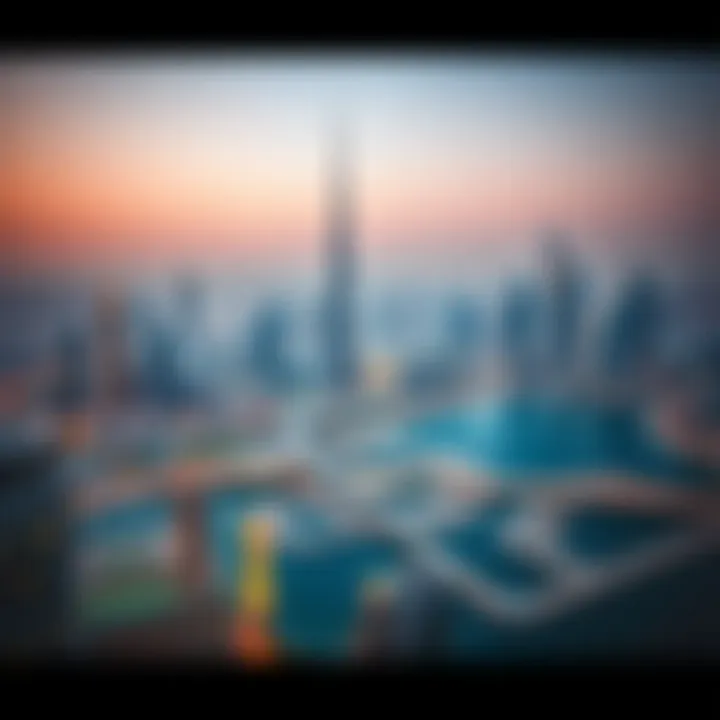
Intro
Dubai's skyline, a testament to human ambition and architectural innovation, has evolved from a modest collection of low-rise buildings into a breathtaking panorama of soaring skyscrapers that pierce the clouds. This landscape is not just about height; it’s a vivid narrative of cultural exchange, technological advancements, and purposeful design. In recent decades, Dubai has positioned itself as a global destination, attracting tourists and investors alike, making its skyscrapers vital players in the narrative of its growth.
Understanding the significance of these towering structures extends beyond their impressive façades. Each skyscraper holds stories of visionaries who dared to dream and engineers who transformed those dreams into reality. The evolution of Dubai's architectural landscape is deeply intertwined with economic strategies and cultural ambitions. Thus, it's essential for investors, agents, and potential buyers to grasp not just the designs, but the underlying dynamics that contribute to the city's architectural romance and real estate allure.
As we venture into the architectural and economic intricacies of Dubai's skyline, we will uncover insights into current trends, pivotal investments strategies, and the socio-economic factors shaping the city’s future. Prepare to embark on a journey through glass and steel, understanding not only what stands tall above but also the bedrock of decisions that brought them to life.
A Brief Overview of Dubai's Skyline
Dubai's skyline stands as a potent symbol of human ambition and architectural prowess. The towering structures that grace this urban canvas speak volumes about the city’s rapid transformation from a modest trading port into a global hub of innovation. Understanding the significance of Dubai's skyline is akin to unearthing the layers of its identity, each layer telling a story of cultural evolution, economic aspirations, and a relentless drive toward modernity.
One of the most striking features of Dubai’s skyline is its ability to blend futuristic design with elements of traditional culture, creating a unique architectural language. The juxtaposition of styles, from ultra-modern to more classic influences, invites a deeper exploration of how architecture can be both a reflection of a city’s past and a canvas for its future.
Historical Context
To fully appreciate the architectural magnificence of Dubai, a glance back into its history is essential. In the early 20th century, Dubai was relatively humble, characterized by its small fishing villages and pearl diving trade. The discovery of oil in the 1960s marked a radical turning point, fueling both economic growth and population influx.
As Dubai began to thrive, the skyline started evolving. The emergence of the Burj Khalifa as the world's tallest building in 2010 symbolized not just architectural achievement but the city’s newfound ambition. Looking at the historical context helps to understand how economic prosperity catalyzed a race toward architectural prowess, with international firms vying to leave their mark.
The Transformation of Urban Space
Dubai's skyline is not merely a collection of tall buildings; it illustrates the transformation of urban space into something far more integrated and functional. The verticality of its structures has become a response to the challenges of space in a city that is relatively young and geographically limited. This urban vertical development serves multiple purposes: it optimizes land use while enhancing the aesthetic appeal of the city.
The deliberate placement of skyscrapers is also indicative of strategic urban planning. Iconic buildings like the Burj Al Arab and the Emirates Towers aren't just places to live or work; they’ve been positioned to attract tourists and investors alike, adding layers of commercial success to their architectural grandeur.
In summary, the brief overview of Dubai's skyline encapsulates how past and present coalesce, providing insights into the driving forces behind one of the most impressive urban landscapes in the world. This architectural landscape serves as a testament to what can be achieved when ambition meets innovative design, setting the stage for a city that continually strives for the sky.
Significant Skyscrapers of Dubai
The skyline of Dubai isn’t just a collection of tall buildings; it’s a testament to human ingenuity and architectural brilliance. These architectural giants, known as skyscrapers, symbolize the city’s rapid growth and its aspirations to be a global hub for business and tourism. Understanding the significant skyscrapers of Dubai allows us to appreciate their roles not only in shaping the physical landscape of the city but also in driving economic progress and attracting international attention.
The skyscrapers here aren’t mere structures; they are landmarks that encapsulate the identities of the neighborhoods they stand in. Each one serves specific purposes, whether for hospitality, office space, or residential living, contributing to a multifunctional urban landscape. Additionally, these skyscrapers often showcase cutting-edge designs and innovative technology, paving the way for sustainable architecture in the region.
Burj Khalifa: The Pinnacle of Innovation
Burj Khalifa stands like a sentinel over Dubai, making a loudstatement in the world of architecture and engineering. Standing at a staggering 828 meters, it is currently the tallest building globally. Completed in 2010, Burj Khalifa has raised the bar for skyscrapers, incorporating sleek aesthetics with functional design.
What sets the Burj Khalifa apart is not just its height, but also its design inspired by traditional Islamic architecture. The building's three-wing configuration allows for maximized views of the surrounding landscape.
- Unique Features: The observation deck on the 148th floor offers an unparalleled perspective of the city's sprawling landscape, enhancing tourism significantly. Additionally, it uses a high-speed elevator system that propels visitors at remarkable speeds, furthur blurring the lines between the mundane and the extraordinary.
- Engineering Feat: It’s built to withstand high wind-load pressure, a pertinent consideration for structures in this region.
Burj Al Arab: A Symbol of Luxury
The Burj Al Arab, often dubbed as the world's only seven-star hotel, is a striking symbol of opulence and luxury. Constructed on an artificial island, its iconic sail-shaped silhouette makes it a staple in Dubai's landscape. The 321-meter tall hotel has become synonymous with indulgence, attracting celebrities and dignitaries alike.
The appeal lies in its architectural prowess, offering lavish accommodations with exceptional service. Guests enjoy amenities such as a helipad and submarines for underwater dining experiences.
- Luxury Redefined: With its lavish interiors and exclusive services, Burj Al Arab positions itself as more than just a hotel; it is a brand.
- Cultural Landmark: The hotel reflects the luxury lifestyle associated with Dubai, drawing visitors keen to witness its grandeur firsthand.
Etihad Towers: A Multifunctional Marvel
The Etihad Towers not only redefines Dubai’s skyline but also offers a blend of residential, office, and hotel spaces all in one complex. This five-tower development showcases modern aesthetics blended with practical functionality. Rising a total of 1,000 feet, it has become an important business and living hub in the city.
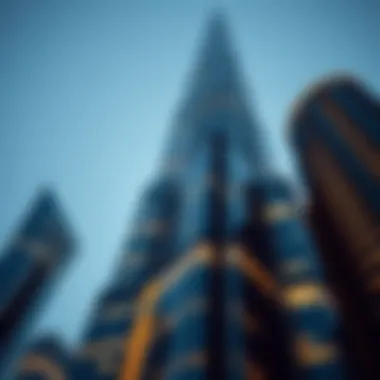
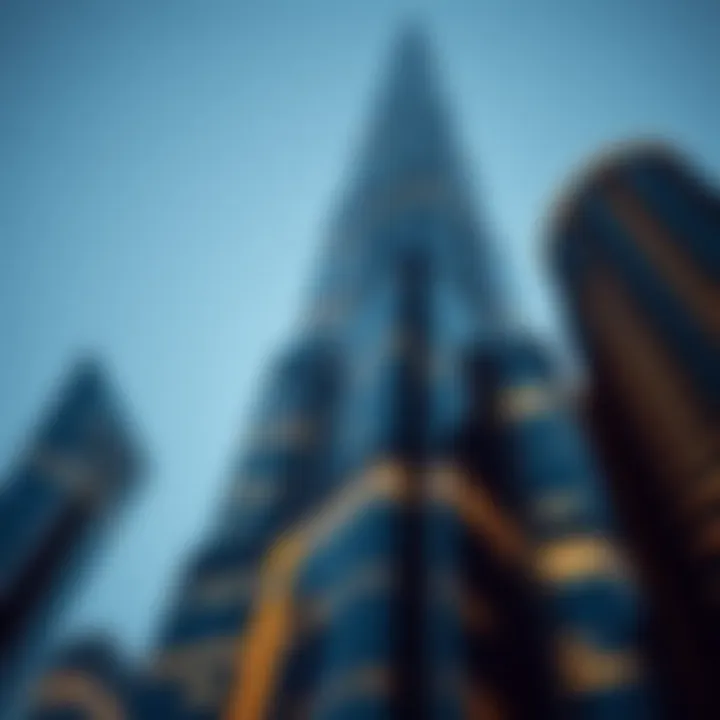
Each tower serves distinct purposes. Tower Two, for instance, features a luxury hotel while Tower One houses residential apartments. This multifunctional approach is a practical solution for urban living, catering to the diverse needs of residents and visitors.
- Community Integration: The towers are surrounded by expansive grounds with gardens, making them inviting spaces for both local inhabitants and tourists.
- Architectural Cohesion: The design incorporates elements that relate to the traditions of the UAE, while still feeling futuristic and ahead of its time.
The Index: A Mixed-Use Icon
The Index is a remarkable addition to Dubai's architectural landscape, showcasing the potential of mixed-use buildings. Towering at 328 meters, it combines residential, commercial, and office spaces, reflecting the dynamics of urban living.
The unique cylindrical design and notched shape set it apart from the conventional skyscrapers. One can find many lifestyle options within a single location, including shops and eateries, echoing the concept of live-work-play developments.
- Sustainable Growth: The development emphasizes a sustainable approach, promoting energy-efficient technologies in its operations.
- Cultural Integration: Curiously enough, its design also mirrors local cultural motifs, demonstrating how contemporary architecture can harmonize with tradition.
“Dubai's skyscrapers not only scrape the sky; they shape the future of urban living.”
Architectural Styles in Dubai's Skyscrapers
The architectural styles of Dubai's skyscrapers serve as crucial indicators of the city's identity and ambition. These structures don’t just scrape the sky; they reflect a fusion of tradition, innovation, and artistry that encapsulates the spirit of a modern metropolis. Understanding these styles offers insights into the engineering prowess that defines the skyline and reveals the ethos behind urban growth in a city that has rapidly evolved into a global hub.
Contemporary Design Elements
Dubai’s architectural marvels showcase contemporary design elements that are functional yet visually striking. These skyscrapers often employ sleek lines, reflective glass facades, and innovative shapes that defy conventional building norms. The Burj Khalifa, for instance, is more than just tall; its unique Y-shaped plan enhances stability and provides panoramic views, pushing the envelope of design in response to both aesthetics and utility.
"The skyscrapers of Dubai are not just structures; they are statements of vision and ambition that challenge the very definition of architecture."
Apart from form, materials play a significant role in contemporary skyscraper design. Lightweight materials and advanced construction techniques enable these buildings to rise to impressive heights while maintaining resilience against harsh weather conditions. Features such as green roofs, integrated solar panels, and advanced insulation contribute not only to energy efficiency but also to the lavish look and feel of the interiors, which often boast high-end finishes.
Cultural Influences in Architecture
Dubai's skyscrapers are also a canvas upon which cultural narratives are woven into the fabric of architectural design. The influence of Islamic architecture can be spotted in the intricate detailing and geometric patterns that communities have cherished for centuries. Buildings like the Burj Al Arab showcase elements of Persian design, captured through the use of flowing curves and decorative motifs that harken back to traditional artistry.
However, it’s not a one-way street; globalization has allowed architects to draw inspiration from various cultures around the world. The result is a melting pot of architectural influences, from the minimalist aesthetics of Japanese design to the bold, expressive forms found in Western skyscrapers. This synthesis creates a skyline that not only addresses local cultural narratives but also places Dubai in the broader global conversation on modern architecture.
Sustainable Architecture Approaches
In the quest for vertical living, sustainability has become an essential consideration in the design of Dubai's skyscrapers. With rapid growth leading to increased energy demands, integrating sustainable architecture practices is not merely an option; it's a necessity. Buildings like the Eco Tower articulate a commitment to sustainability through their design and operational strategies.
Various approaches have been adopted, such as utilizing energy-efficient systems, rainwater harvesting, and advanced waste management strategies. Passively designed elements, including natural ventilation, foster a comfortable indoor environment while minimizing energy consumption. The emphasis on local materials further reduces carbon footprints, and innovative landscaping transforms rooftops and balconies into green spaces that mitigate urban heat.
By embedding these sustainable features into the planning and construction process, Dubai's skyscrapers embody the idea that luxury and environmental responsibility can indeed go hand in hand.
In a nutshell, the architectural styles witnessed in Dubai's skyscrapers highlight not just technical feats of modern engineering but also a rich tapestry of cultural and sustainable practices. This informative blend captures the essence of a city that refuses to settle for anything less than extraordinary.
Economic Impact of Skyscrapers
The towering structures that define Dubai's skyline are not just visually striking; they serve as engines for economic growth. This section delves into the substantial economic impact skyscrapers have on Dubai, highlighting how they contribute to tourism, influence real estate valuations, and create job opportunities.
Tourism and Economic Growth
Dubai's skyscrapers are a colossal attraction for millions of tourists each year. The iconic Burj Khalifa, for example, draws visitors from across the globe, eager to stand atop the world's tallest building. The experience offers breathtaking views and serves as a vital touchpoint, enhancing Dubai's appeal as a tourist destination.
- Key Contributions to Tourism:
- The skyline’s architectural wizardry transforms mere tourists into potential investors.
- Major events, such as the annual New Year's Eve fireworks launched from the Burj Khalifa, solidify the city’s reputation as a festive hub.
- Hospitality stats reveal a direct correlation between skyscraper visibility and increased hotel bookings during peak seasons.
It’s not just about aesthetic allure; this influx of visitors feeds into various sectors of the economy, from retail to hospitality, creating a hefty financial ripple effect.
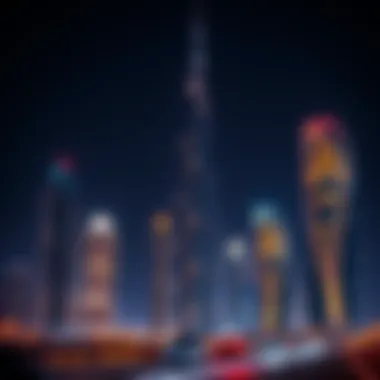
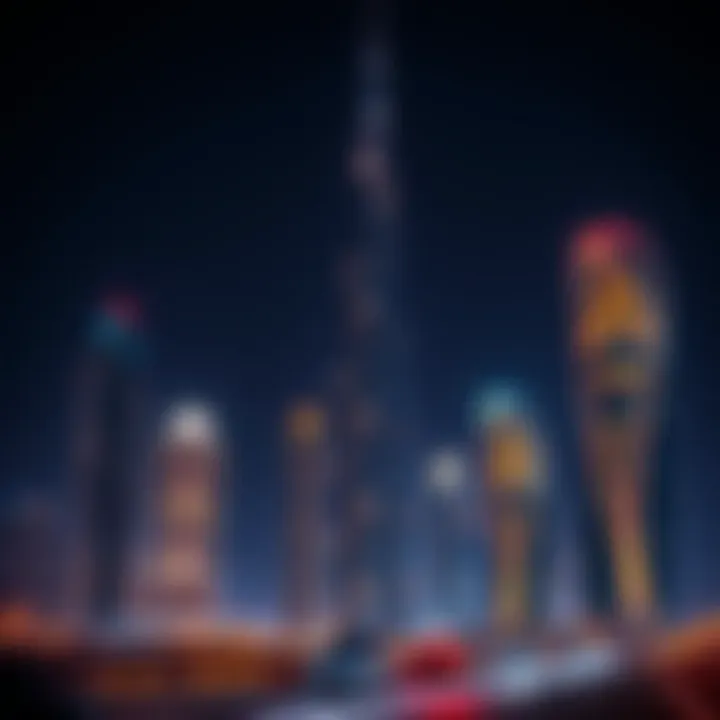
Real Estate Valuation Trends
The presence of skyscrapers in Dubai heavily skews property values upward. Luxury developments sighted in high-rise buildings tend to yield a higher return on investment, driving both local and foreign investments. Potential buyers and agents alike watch market fluctuations closely, and here are some trend highlights:
- Luxury Demand Surge:
- Market Speculation:
- Properties in proximity to premier skyscrapers experience inflated prices, capturing affluent buyers looking for exclusivity and prestige.
- Sky-high rentals in buildings like the Address Downtown showcase this trend, assuring a steady stream of income for investors.
- As new skyscrapers break ground, speculations often arise, driving pre-sales and rentals before completion. This dynamic creates a buzz in the real estate market.
Overall, skyscrapers significantly impact market valuations, making Dubai a hotspot for property speculators and investors.
Job Creation and Employment Opportunities
Skyscraper development in Dubai is synonymous with job creation. The construction and operational phases of these majestic towers depend heavily on a diverse workforce. Consider these dimensions:
- Direct Employment Opportunities:
- Indirect Job Creation:
- Hundreds of skilled and unskilled workers find jobs in the construction of skyscrapers, from architects and engineers to tradespeople.
- Once operational, these buildings require staff for management and concierge services, leading to sustainable employment.
- Job growth extends to associated industries like construction materials, logistics, and maintenance services, creating a supportive ecosystem.
- Increased tourism often leads to job opportunities in the hospitality sector, enhancing services around these architectural behemoths.
In summary, skyscrapers do more than scrape the sky; they provide a foundation for economic stability and growth, solidifying Dubai's place as a vibrant international city.
The economic relationships fostered through skyscraper developments are intricate, leading to a bouquet of opportunities for various sectors in Dubai.
For further reading and statistics on the economic impact of skyscrapers, consider visiting britannica.com or en.wikipedia.org.
The Future of Skyscraping in Dubai
Looking over Dubai's skyline, it's clear that the future promises more than just height. As architects and developers sketch out plans, they aren't just aiming for records; they're weaving a narrative of sustainability, technology, and imaginative design. The future of skyscraping in Dubai isn’t just about looking up but also about integrating with the environment and enhancing the urban experience.
The importance of this topic lies in understanding the interplay between technological innovation, urban planning, and the cultural context. Investors and stakeholders must grasp these elements to navigate the upcoming trends and opportunities effectively. Here are some critical considerations that will shape the future of Dubai's vertical landscape:
- Sustainability Initiatives: As cities grapple with climate change, Dubai will, undoubtedly, pivot toward energy-efficient designs and eco-friendly materials.
- Innovative Use of Space: Concepts such as mixed-use developments will drive new projects, effectively blending residential, commercial, and hospitality spaces within vertical structures.
- Socio-Economic Impact: The future designs will not only cater to tourists but also serve the local community, injecting urban spaces with life and activity.
By embracing these pioneering approaches, Dubai aims to redefine what a skyscraper can be.
Proposed Projects and Innovations
Post-2020, the proposed skyline reveals a rich tapestry of projects set to elevate Dubai's architectural portfolio. One of the standout propositions includes the Dubai Creek Tower, which seeks to challenge even the mythical Burj Khalifa. It’s designed to soar beyond 1,000 meters, but its ambition goes beyond mere height. Designed by the acclaimed architect Santiago Calatrava, this structure is slated to use cutting-edge light and shade technologies, enhancing energy efficiency significantly.
Another incredible project is the Dubai Square, an immersive retail and lifestyle destination. This development will push urban boundaries by combining shopping, leisure, and next-generation tech innovations, all under one roof. While these projects look incredible on paper, their reality will hinge on the successful integration of community and environment-friendly practices.
Technological Advances in Construction
As we look toward the future, technology is set to play a substantial role in transforming how skyscrapers come to life. One such innovation is the application of 3D printing in construction processes. This technique promises reduced waste, faster build times, and the potential for extraordinary designs. Concrete 3D printing is gaining traction and may soon serve as a primary method for creating complex structures efficiently.
Moreover, the use of drones and AI technology not only optimizes construction sites but also enhances safety and precision. Drones can monitor building progress, while AI algorithms analyze the data to predict potential challenges and streamline the workflow.
Additionally, the integration of smart building technologies, focusing on automation and energy management systems, will be paramount. For instance, buildings equipped with IoT sensors will be able to manage lighting, heating, and cooling based on the occupants' routines and preferences; this will significantly reduce energy consumption.
The marriage of these technologies redefines skyscraper construction and pushes Dubai further into its response for a futuristically sustainable urban environment.
"As we step into a new era of urbanization, the skyline of tomorrow embodies not just ambitious peaks but a responsible, community-driven approach to city living."
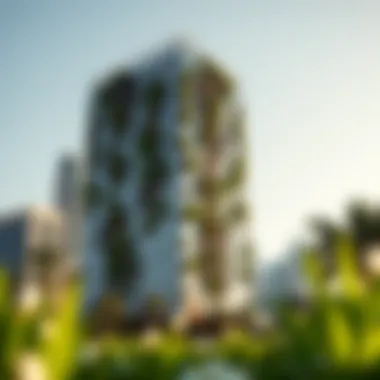
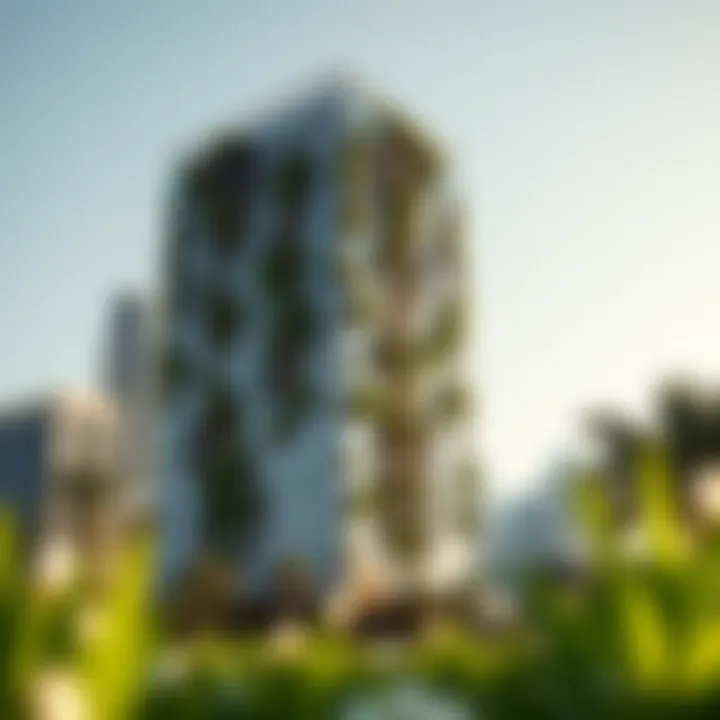
In summary, the future of skyscraping in Dubai is not just an architectural endeavor; it's a holistic approach that integrates technology, sustainability, and community. As these developments unfold, they will continue to reshape the identity of the city while inviting global attention and investment, paving new avenues for growth in the heart of the UAE.
For more on architectural innovations in skyscrapers, check out Britannica and Wikipedia.
Also, consider joining discussions on platforms like Reddit for insights from the community.
Challenges Facing Skyscraper Development
As Dubai continues to be a frontrunner in architectural innovation, it’s important to recognize that the journey of constructing skyscrapers is not without its hurdles. Understanding these challenges is crucial for investors, real estate agents, analysts, and expatriates who are interacting with or interested in the region's real estate market. Navigating the complexities of skyscraper development requires a keen awareness of the intersection between environmental impacts and regulatory frameworks.
Environmental Considerations
The ecological footprint of skyscraper construction in Dubai is a significant concern. The emirate's rapid urbanization has resulted in substantial environmental challenges. For instance, the extreme heat prevalent in the region necessitates extensive energy use for cooling, which can offset sustainability goals.
To mitigate these effects, developers are increasingly turning to innovative materials and design strategies that emphasize energy efficiency. Green roofs, advanced cooling technologies, and solar panels are examples of how skyscrapers can lessen their environmental impact. Furthermore, local regulations are tightening around sustainability standards, pushing architects and builders to adopt more responsible practices.
"Sustainable architecture is not just a trend; it’s a necessity in cities where the environment and urban growth must coexist."
Here are some critical points developers need to consider regarding environmental impacts:
- Resource Consumption: The amount of water and building materials used contributes to environmental degradation.
- Biodiversity: Large-scale developments can disrupt local wildlife habitats.
- Waste Generation: Construction sites produce significant waste, necessitating robust management plans.
By integrating sustainable methodologies, developers can help ensure the health of the city’s ecosystem while still achieving architectural grandeur.
Regulatory and Zoning Issues
Navigating the maze of regulatory and zoning laws in Dubai can be both a challenge and a necessity. The process involves several governmental bodies, each with its own set of rules and regulations. Licensing requirements, construction permits, and adherence to building codes can complicate or delay projects significantly.
Moreover, zoning laws dictate the height, density, and purpose of buildings within certain areas. These restrictions are designed to maintain order within the urban landscape, ensuring that the aesthetic and functional integrity of Dubai's skyline remains intact. Failing to adhere to these guidelines can lead to penalties or project cancellations.
In light of these regulatory hurdles, here are key factors to keep in mind:
- Approval Processes: Lengthy approval timelines can impact project scheduling and financing.
- Compliance Costs: Meeting regulatory requirements often involves additional costs that can strain budgets.
- Adaptation to Changes: Rapid changes in laws may require developers to adapt their projects mid-course, which can be both costly and time-consuming.
For investors and stakeholders, understanding these regulatory landscapes is critical for making informed decisions in Dubai’s dynamic real estate market. Staying ahead can often mean the difference between a successful venture and one fraught with obstacles.
The End: The Essence of Dubai's Colonial Aspirations
The transformation of Dubai's skyline is not just a tale of architectural brilliance but an emblematic reflection of its colonial aspirations—and this extends beyond mere bricks and mortar. The skyscrapers of Dubai are physical testimonies, inviting reflections on how far the city has come and the ambitions that propel it into the future. These towering structures stand tall against a backdrop of history that includes colonial influences, trade dynamics, and modernization efforts.
The significance of this topic lies in exploring how the development of skyscrapers symbolizes a broader narrative of urban identity and economic potential. Dubai emerged from its humble beginnings as a small trading port into a global hub, shaping its colonial legacy as a stepping stone towards its modern aspirations. This ongoing evolution enhances the city's landscape not just in aesthetic terms, but also social, economic, and cultural considerations.
This chapter serves to encapsulate various factors about Dubai’s ambitious structures:
- Identity Formation: The skyscrapers in Dubai are not merely buildings; they represent the desires and identities of a multicultural society striving for recognition in the global arena. Each structure narrates a story of aspiration and resilience.
- Economic Strategy: They bolster the economic ethos of Dubai, enhancing tourism, attracting investments, and elevating the real estate market to remarkable heights. These architectural landmarks serve as both attractions and business centers, contributing to the overall growth narrative.
- Cultural Dialogue: The influence of diverse cultures in the design and function of these skyscrapers opens dialogues between traditional values and modern needs, attempting to blend the past with the present.
In examining these elements, one may say that Dubai’s skyscrapers are more than just impressive structures; they symbolize a unique fusion of history, ambition, and future prospects. Through this lens, we can appreciate how the urban landscape has been shaped not only by the colonization process but also by a continuous journey toward redefining identity.
Reflecting on the Journey
The journey of Dubai's architectural landscape is a rich tapestry woven with ambition, engineering, and vision. Reflecting on how this all began, one could look at the modest structures that once framed the city and compare them to the titans of engineering that now light up the skyline. This evolution hints at a profound societal shift spearheaded by visionary leadership and a diverse populace willing to adapt and innovate.
Every skyscraper represents countless dreams—those of architects, investors, and citizens alike. They are a culmination of resources, technology, and creativity. Each building, from the iconic Burj Khalifa to the luxurious Burj Al Arab, tells a story of bold aspirations pushing against geographical and cultural limits. Not just a backdrop for the residents but a central character in the story of Dubai's post-colonial identity, these structures invite observers to contemplate what it means to aspire for greatness.
“Quite simply, the skyscrapers of Dubai are the dreams of a nation etched in glass and concrete.”
The Role of Skyscrapers in Shaping Identity
In analyzing the role of skyscrapers in shaping Dubai's identity, one can’t ignore the profound impact these structures have had on both a local and global scale. They play an essential role in branding Dubai as a beacon of modernity in the Arab world and serve as a visual representation of its collective identity.
- Cultural Symbols: Each noteworthy skyscraper carries specific cultural symbolism, contributing to the multifaceted identity of the city. For instance, the Burj Al Arab not only stands as an architectural marvel but also represents luxury and opulence, a characteristic that Dubai has cultivated over decades.
- Attracting Global Attention: Skyscrapers have transformed the city into a global meeting point, drawing attention from international business, tourism, and expat communities. This blending of cultures molds a unique metropolitan identity that embodies progress, tolerance, and ambition.
- Innovation and Technology: These buildings reflect the city’s commitment to adopt cutting-edge technologies and health sustainability practices. Innovations displayed in their designs often influence emerging trends worldwide and cement Dubai's place in the global architectural narrative.
Thus, the skyscrapers of Dubai do more than touch the sky; they symbolically ground the aspirations of their people. Looking ahead, they continue to shape and redefine what it means to call this remarkable city home.



